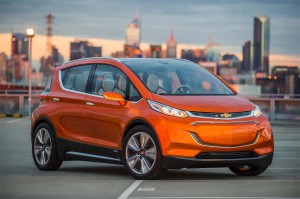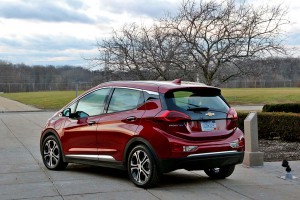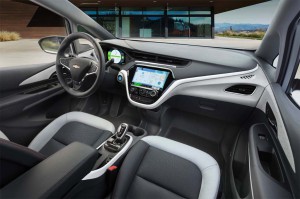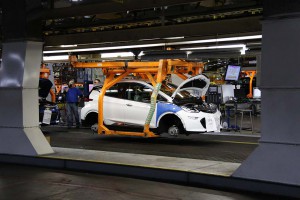It’s no surprise that the first generation of battery-electric vehicles barely registered on the U.S. sales charts. They were small, costly and, with the exception of a few luxury-priced Teslas, not very much fun to drive. Add limited range and only the most green-minded buyers were willing to plug in.
But the equation is about to change and, if a handful of new models deliver what they’re promising, we could begin to see electric propulsion move into the mainstream. First out of the box is the new Chevrolet Bolt EV. With a range of 238 miles and a price tag dipping below $30,000 – once you factor in the $7,500 federal tax credit – there’s a lot to like about the Chevy hatchback.
We’ve now had three stints behind the wheel of the Bolt EV, including our first drive of a pre-production prototype last January. While it may not have the cache of the Tesla Model 3 – which won’t make it to market until the second half of 2017 at the earliest – the new Chevy battery-electric vehicle, or BEV, really delivers on all its promises. It’s surprisingly quick, roomy and able to deliver nearly as much range as comparably sized gas vehicles, such as the Chevrolet Sonic.
(Click Here to take a tour of the Chevrolet Bolt EV assembly plant.)
We’re going to need more time behind the wheel – among other things to see what it’s like to keep it charged up – but here are our initial impressions.
From a visual standpoint, the Chevy Bolt EV might trigger a sense of déjà vu. And no surprise. It shares key components and much of its basic design with the gas-powered Sonic. The two cars, in fact, roll out of the same assembly plant in the Detroit suburb of Orion Township. That’s more than a logistical factoid; by sharing the same line General Motors was able to hold down production costs.
Though the Bolt and Sonic look quite similar, there are a few notable differences. The EV, for one thing, eliminates the traditional rocker panels. That makes it just a bit easier to climb in and out. In turn, that’s likely to appeal to those who will first experience Bolt when they schedule a trip with ride-sharing service Lyft. Chevy plans to make the Bolt EV available to drivers at a heavily subsidized lease price in order to show off the battery-car to Lyft customers – hoping some will be impressed enough to buy one.
One of the advantages of battery cars is that you don’t have a big engine in front of the driver. And unlike most first-generation BEVs, Chevy has placed both Bolt’s battery pack and its electric motor under the floor. Now, add the use of specially designed seats and you find the new Chevy offering class-above interior space.
Those seats, incidentally, adopt an unusual asymmetric design that allows for a larger center console than you’d normally find in a vehicle with a width of only 69.5 inches. The console has plenty of space for a cellphone, cups and armrests, as well. There’s also a nice sized bin for a purse or pack.
(Chevy Bolt named Green Car of the Year. Click Here to learn why.)
More importantly, there’s plenty of room for two adults in back, three in a pinch. As for the cargo compartment, it can handle 17 cubic feet with the back seats up. Reasonable for a hatchback of this size.
The instrument panel, as we’ve come to expect from battery-based vehicles, is fully digital and offers the requisite displays showing charge status, ranger and tips on getting the most out of the battery.
The center console also features a 10.2-inch touchscreen display. To our surprise, navigation is not available. Instead, you’ll have to tap into the navi software on your smartphone using either Apple CarPlay or Android Auto.
And on the safety front, the Chevrolet Bolt EV offers plenty of technology, including forward collision warning and blind-spot detection, a 360-degree around view camera monitor, a backup camera and even a rearview camera mirror. Most of those features come standard on the highline Bolt Premier, which starts at $41,780 before federal credits, along with heated leather front and rear seats and roof rails.
While such features are appealing, they’re not why you’d likely consider the Bolt, however.
The Bolt isn’t the first long-range electric vehicle. Tesla can lay that claim with the Model S sedan and, more recently, the Model X SUV. But those two models start at roughly twice the price of the little Chevy and can push well into the six-figure range. Tesla plans to deliver about 200 miles per charge with the Model 3. That could change but for now, it lags the 238-mile figure the EPA has given Bolt – and will be a few thousand more expensive than the Chevy.
Along with price, range anxiety is considered one of the biggest obstacles to widespread acceptance of EVs. Bolt is well-positioned to break that barrier. The other issue is charging times. If you’re going to plug into a standard wall socket, expect to be tethered for as much as 30 hours to fully recharge the hatchback’s 60-kilowatt-hour pack. Using the standard 240-volt, 32-amp Level 2 charger will require a 10-hour charge.
You can also opportunity charge at, say, your office or one of the many shopping centers now offering chargers, getting about 25 additional miles per hour. Or, if you have access to one of the newer 480-volt Level 3 DC chargers Bolt will get an 80% “fill-up” in just over 30 minutes.
(Major automakers teaming up on super-fast EV charging project. Click Here for the story.)
That’s moving in the right direction though still not comparable to what owners are used to with a gas-powered car. The good news is being able to plug in at home each night. And, using the Bolt’s smartphone app, you can take advantage of off-peak electric rates while also setting the cabin to automatically warm or cool, as needed, before you head to work each morning.

The Chevrolet Bolt EV can use Level 1, 2 or 3 chargers, the latter handling 80% recharge in under 1 hour.
Early on, most manufacturers decided to maximize range at the expense of performance. Chevy has struck a nice balance. No, it’s not as quick as a Tesla Model S running in Ludicrous Mode, but a 0 to 60 launch of around 6.5 seconds is nearly on par with that of a base Ford Mustang.
Power, incidentally, is delivered to the front wheels by a single permanent magnet AC motor making 200 horsepower and 266 pound-feet of torque. Chevy has electronically limited top speed to 93 mph. And the reality is that you don’t want to be going that quick very often. The faster you go the lower your range.
One interesting features is the addition of what look like paddle shifters. Since there’s a single-speed gearbox you know they have another purpose – sharply increasing the amount of regenerative braking the Bolt is capable of. The more energy you recapture while braking the longer your range. But you can also use the paddles for one-foot driving in heavy traffic, as the car slows much more aggressively when you lift off the throttle and will even come to a complete stop without touching the brake.
Carrying about 800 pounds of batteries, the Bolt EV isn’t light. At 3,569 lbs, its curb weight is 600 to 800 pounds heavier than the Sonic, depending on model. That mass is apparent when you hit a pothole, but by moving the battery pack below the floor, the Bolt has a surprisingly low center of gravity that makes it handle corners a lot more aggressively than you might otherwise expect. The overall ride is comfortable, reminiscent of the bigger Chevrolet Malibu.
It all adds up to the sort of product we’d expect green-minded buyers to rush to the showroom to order. The question is whether more mainstream buyers will opt in, as well. While GM isn’t talking numbers, the Bolt’s battery supplier, Korean-based LG Chem, has said it expected to provide enough packs for around 30,000 Chevy Bolt EVs in 2017.
That’s a fraction of the more than 400,000 advance registrations Tesla has taken for the Model 3, and it reflects the generic skepticism about Chevrolet among techies and greenies. But considering the numerous awards Bolt is winning, that could change.
If our initial time behind the wheel is any indication, the 2017 Chevrolet Bolt is going to be a real game-changer. Yes, there are still some compromises, but the hatchback comes as close as any vehicle so far on the market to becoming a truly acceptable alternative for the internal combustion engine. It may be a cliché, but Bolt really is the game-changer battery-car proponents have been longing for.






I’ve only seen general notes, i.e. “a/c use does reduce range somewhat”, but for those southerners who need it 9 1/2 months each year, it is a serious question. And becomes more pertinent as cars like the Bolt begin to be able to substitute for the traditional gas commuting vehicle. And as the average vehicle age passes 11 years, battery replacement questions will very quickly arise. I’m interested enough to want to know, now.
One interesting tidbit: both Toyota with the NiMH batteries in their Prius, and GM with the LiON batteries in the Volt plug-in claims to not have had any battery failures. And the decline in state-of-charge has been absolutely in line with original modeling. So, that would suggest you will get the full life promised.
Paul E.
I once read that the Volt’s Voltec system was, ‘Over-Engineered’. The battery, (currently limited to a 50 mile range in the 2017 Volt), can actually store DOUBLE that amount.
But what GM has done is limit a ‘full’ charge to half the battery’s capacity to be sure that the battery evenly cycles between cells, maximizing lifetime efficiency. It’s how they guarantee 10 years or 100,000 miles. In addition, they ensure that battery temperatures are controlled and adjusted as necessary, which also helps the overall life of the battery.
Most devices that use LiON batteries do not do anything like this. Phones are notorious for allowing a full battery rundown (understandable, since physical space is too limited for any real extra capacity), but over time that just destroys a battery.
My 2014 Volt seems to perform just as good as it did back in 2014, however extreme cold or heat does affect the charge efficiency of the battery in proportion to the amount you get away from the moderate temperature of 70 degrees or so.
For instance, it was a chilly 34 degrees this morning. After a full overnight charge, I’m reading 35 out of the normally 38 miles available.
And yes, using the heat or AC will definitely affect your total distance, but there are certain tricks you can use, in particular with the Volt, to conserve charge and maximize your electric-only distance.
CT, I spent a bunch of time with GM battery lab and Bolt team members last week (see: http://www.thedetroitbureau.com/2016/12/getting-it-right-inside-the-chevy-bolt-ev-plant/). A couple thoughts:
* In the original version of the Volt, GM was still not confident with lithium-ion technology and only used about 60-65% of the gen-1 battery’s state-of-charge, or total capacity;
* As confidence grew, they increased the amount the plug-in used, which is why late Gen-1 cars had their EV range increased slightly;
* They are using more than 3/4 of the battery in the Volt now, and while they won’t reveal the exact figures for Bolt, it is “competitive” with what other makers are using, probably in the 90% capacity range, but not up to the 95%+ that Tesla has opted for;
* While impossible to get numbers, Tesla insiders acknowledge they had issues early on with Roadster and Model S batteries (they won’t discuss more recent models), including bricking, where the batteries fail completely;
* Both Volt and Bolt EV have liquid-cooled packs. Or, more accurately, liquid-based climate control. The battery pack actually will be heated in a cold environment to improve charging efficiency. In fact, LiON batteries tend to like to be warmer when charging than when discharging. That’s complicated, but is, in part, due to issues related to internal resistance;
* By using the HVAC system, GM claims it actually minimizes the losses connected with operating in extreme temperature environments, but what you experience is normal, and batteries will drain faster when a driver uses heat or AC, as well as headlights, etc.
I’m curious what some of your range-enhancing tricks are, BTW.
Paul A. Eisenstein
Publisher, TheDetroitBureau.com
That’s interesting, I didn’t know about the increase in usable battery. I would’ve loved to visit GM just to talk about that.
Anyway, one trick I learned is to ‘warm’ up the battery (and the cabin) about 1/2 hour ahead of departure in cold weather, using remote starting. The remote start warms things up for 10 minutes, then shuts down.
This heats up the cabin and the battery just enough to take the edge off – AND – the battery will store a little extra for you in the remaining 20 minutes as a result.
This has been especially useful in this extreme cold (I live in PA).